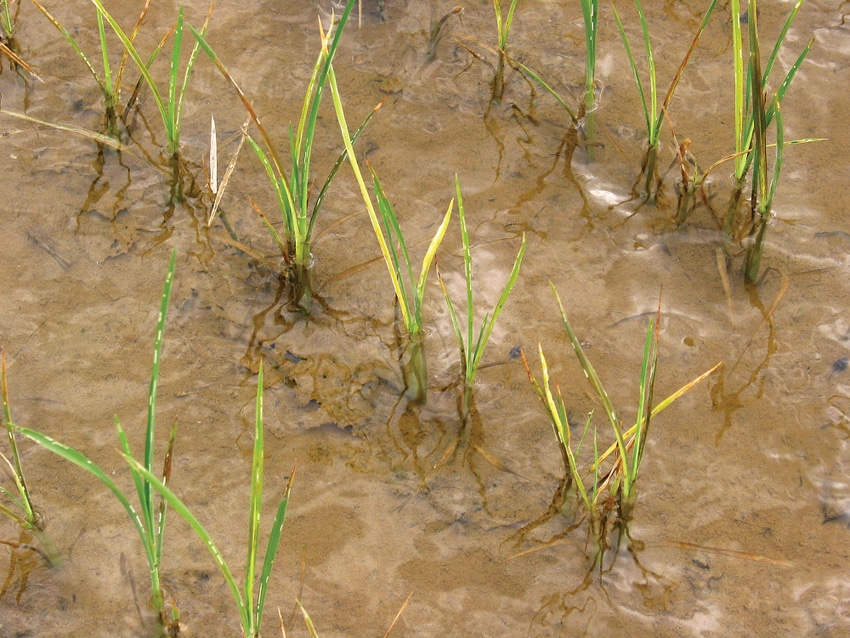
For the well-trained eye, spotting Zn deficiency prior to flood might be easy, but for most people it has to be something you are really looking for in order to recognize. Zinc deficiency symptoms before flooding may be very subtle until establishment of a permanent flood and when things go bad, they accelerate quickly.
May 21, 2012

Ask a producer who has had zinc (Zn) deficiency and he can tell you that it is not something you will soon forget. One day your rice will look great and two days after flooding you think it’s the end of the world.
For the well-trained eye, spotting Zn deficiency prior to flood might be easy, but for most people it has to be something you are really looking for in order to recognize. Zinc deficiency symptoms before flooding may be very subtle until establishment of a permanent flood and when things go bad, they accelerate quickly.
The following symptoms can often be used to identify Zn deficiency pre- and post-flood, but the symptoms will often worsen following the establishment of a permanent flood.
Symptoms of Zn deficiency include:
1. Stacking of leaf sheaths or joints (easiest pre-flood identification and also post-flood symptom).
2. Bronzing of oldest leaves (pre- and post-flood symptom).
3. Basal leaf chlorosis — the portion of the leaf nearest the stem becomes light green (pre- and post-flood symptom).
4. Leaves float on water following establishment of a flood (post-flood symptom — not as reliable and usually occurs in deep flood).
5. Lack of vigorous growth following pre-flood N application and reduced tillering.
6. Symptoms are usually worst on the deep-water side of the levee and area aggravated by cold water and cool air temperatures.
7. Rice death.
Zinc deficiency can often be confused with phosphorous (P) deficiency or salinity injury. Problems associated with Zn deficiency are normally seen after flushing or flooding; salinity problems usually occur when the soil is not saturated.
Zn deficiency and salt injury can occur in the same field, but the symptoms will most often present themselves at different times. Although P deficiency will also occur after flooding, the leaves will generally not exhibit the basal chlorosis and will usually remain erect (P-deficient rice leaves do not float on the water).
In both P and Zn deficiencies, lack of leafiness and lack of tillering can occur, so look for the basal leaf chlorosis to differentiate between these two nutrient deficiencies.
Producers who notice Zn deficiency within the 72 hours following flood have a hard decision to make — to drain or not to drain. In cases of severe Zn deficiency, draining the field is the only way to save the rice crop.
Immediately following identification of Zn deficiency, follow these steps to salvage rice. It can take as long as 14 days for the visual recovery to occur.
Steps to salvage rice from Zn deficiency
1. Drain the field and allow the soil to dry — application of zinc products into the floodwater will not be effective.
2. When new root and shoot growth occur, apply either 1 pound of zinc EDTA per acre or 2 to 2.5 pounds of zinc complexes.
3. Apply 100 pounds of ammonium sulfate and apply a shallow flood.
Even fields that require the salvage treatment can achieve respectable yields and reach as high as 90 percent of the yield potential. The steps required to salvage rice from Zn deficiency will often add two to three weeks to the growing season and draining the field may require the addition of more N fertilizer as a significant amount of the pre-flood N may be lost due to draining, drying and re-flooding the soil.
Although rice can be salvaged from Zn deficiency, a producer’s best bet it to prevent it through soil testing and preplant or pre-flood Zn applications. In all cases, contact your local county agent or refer to Arkansas’ MP 192 guide for more information regarding the identification, prevention and correction of zinc deficiencies in rice.
Trent Roberts is an assistant professor and soil scientist and Nathan Slaton is a professor and soil scientist with the University of Arkansas Division of Agriculture.
You May Also Like



